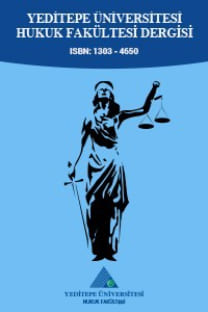The European court of human rights: Quo vadis?
Avrupa insan hakları mahkemsi: gidiş nereye?
___
- E. BATES, The Evolution of the European Convention on Human Rights. From its Inception to the Creation of a Permanent Court of Human Rights, Oxford University Press, 2010.
- M. BOSSUYT, “Should the Strasbourg Court exercise more self- restraint? On the extension of the jurisdiction of the European Court of Human Rights to social security regulations”, Human Rights Law Journal, 2007, pp. 321-332.
- M. BOSSUYT, “You cannot try them, you cannot detain them and you cannot deport them”, Journal des tribunaux, 2012, pp. 352-355.
- N.P. ENGEL, “Mehr Transparenz für die Wahrung professioneller Qualität bei den Richter-Wahlen zum EGMR”, Europaische Grundrechte Zeitschrift, 2012, p. 487.
- R. ERGEC, Protection européenne et internationale des droits de l’homme, Bruxelles, Bruylant, 2006, p. 135.
- J.-F. FLAUSS, “Les élections des juges à la Cour européenne des droits de l’homme”, Revue. Trim. D.H., 2008, p. 713.
- P. LEUPRECHT, “Albert Weitzel et l'adhésion de la Russie au Con- seil de l'Europe” in Mélages en hommage à Albert Weitzel. L'Europe des droits fondamentaux, Paris, Pedone, 2013 (to be published).
- D. TAMM, “The History of the Court of Justice of the European Un- ion Since its Origin”, in Court of Justice of the European Union (ed.). The Court of justice and the Construction of Europe: Analyses and Perspec- tives on Sixty Years of Case-Law, Amazon Kindle, locations 362-72.
- J.-M. SAUVET, “Le rôle du comité 255 dans la sélection du juge de l’Union”, in Court of Justice of the European Union (ed.), The Court of Justice and the Construction of Europe: Analyses and Perspectives on Sixty Years of Case-law, Springer, 2013, Amazon Kindle, location 3019- 30.
- L. WILDHABER, “A Constitutional Future for the European Court of Human Rights?”, in L. WILDHABER, The European Court of Human Rights, Kehl, N.P. Engel, 2006, p. 113-126.
- ISSN: 1303-4650
- Yayın Aralığı: 2
- Başlangıç: 2004
- Yayıncı: Yeditepe Üniversitesi adına Prof. Sultan Tahmazoğlu Üzeltürk
Amerikan hukuk sisteminde hakimin reddi ve çekilmesi, güncel problemler ve reform ihtiyacı
Orhan KARABACAK, Muhiddin KARATAŞ
Anonim şirketler genel kurullarında toplantı ve karar yeter sayıları
Çağdaş vergi sistemlerinde vergi denetimi
Gönüllü vazgeçme düzenlemesi gerekli midir?
Condorcet'nin doğrudan demokrasianlayışı ve 1793 girodine anayasası projesi'ne yansımaları
